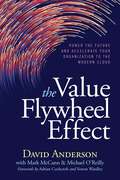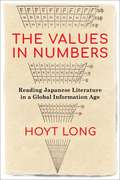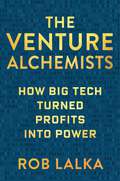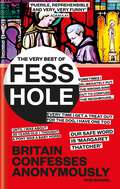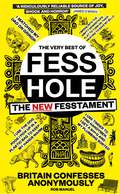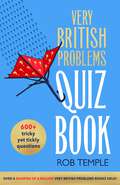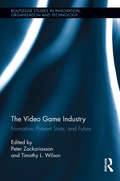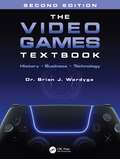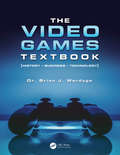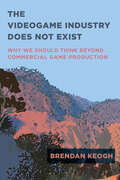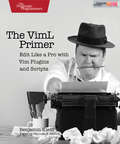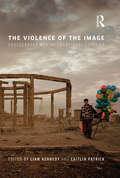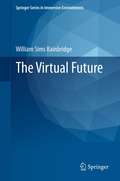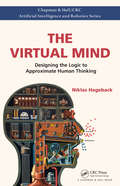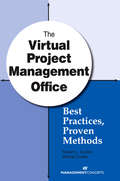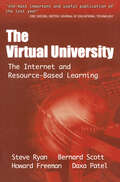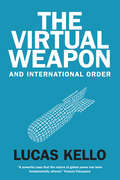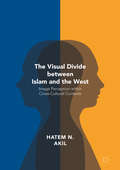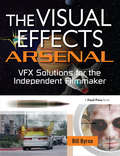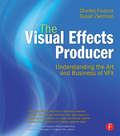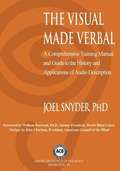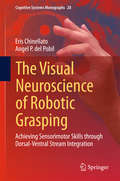- Table View
- List View
The Value Flywheel Effect: Power the Future and Accelerate Your Organization to the Modern Cloud
by David AndersonIt's no secret that technology is moving faster than ever, but current business/IT strategies are not working. To survive the next wave of transformation, the relationship between businesses and technology must evolve. In The Value Flywheel Effect, David Anderson enables leaders to create an adaptive organization built upon embracing strategic thinking, team focus, and reduced time to value to drive business results. The Value Flywheel Effect is a technique already being used by next-generation leaders and companies to succeed in the modern competitive landscape. Combining the power derived from the Value Flywheel and the situational clarity provided by Wardley Mapping, organizations are able to sense and respond to change, easily navigating the rough waves ahead, including migrating to the cloud and serverless. Every company that uses technology must act differently from the companies of yesterday. In The Value Flywheel Effect, David Anderson shows organizations how to understand and utilize the socio-technical intersection between business, technology, and people, giving your organization the edge, it needs to navigate future challenges and build maximum situational awareness.
The Values in Numbers: Reading Japanese Literature in a Global Information Age
by Hoyt LongIdeas about how to study and understand cultural history—particularly literature—are rapidly changing as new digital archives and tools for searching them become available. This is not the first information age, however, to challenge ideas about how and why we value literature and the role numbers might play in this process. The Values in Numbers tells the longer history of this evolving global conversation from the perspective of Japan and maps its potential futures for the study of Japanese literature and world literature more broadly.Hoyt Long offers both a reinterpretation of modern Japanese literature through computational methods and an introduction to the history, theory, and practice of looking at literature through numbers. He weaves explanations of these methods and their application to literature together with critical reflection on the kinds of reasoning such methodologies facilitate. Chapters guide readers through increasingly complex techniques while making novel arguments about topics of fundamental concern, including the role of quantitative thinking in Japanese literary criticism; the canonization of modern literature in print and digital media; the rise of psychological fiction as a genre; the transnational circulation of modernist forms; and discourses of race under empire. Long models how computational methods can be applied outside English-language contexts and to languages written in non-Latin scripts. Drawing from fields as diverse as the history of science, book history, world literature, and critical race theory, this book demonstrates the value of numbers in literary study and the values literary critics can bring to the reading of difference in numbers.
The Venture Alchemists: How Big Tech Turned Profits Into Power
by Rob LalkaWe once idolized tech entrepreneurs for creating innovations that seemed like modern miracles. Yet our faith has been shattered. We now blame them for spreading lies, breaking laws, and causing chaos. Yesterday’s Silicon Valley darlings have become today’s Big Tech villains. Which is it? Are they superheroes or scoundrels? Or is it more complicated, some blend of both?In The Venture Alchemists, Rob Lalka demystifies how tech entrepreneurs built empires that made trillions. Meta started as a cruel Halloween prank, Alphabet began as a master’s thesis that warned against corporate deception, and Palantir came from a campus controversy over hateful speech. These largely forgotten origin stories show how ordinary fears and youthful ambitions shaped their ventures—making each tech tale relatable, both wonderfully and tragically human. Readers learn about the adversities tech entrepreneurs overcame, the troubling tradeoffs they made, and the tremendous power they now wield. Using leaked documents and previously unpublished archival material, Lalka takes readers inside Big Tech’s worst exploitations and abuses, alongside many good intentions and moral compromises.But this story remains unfinished, and The Venture Alchemists ultimately offers hope from the people who, decades ago, warned about the risks of the emerging Internet. Their insights illuminate a path toward more responsible innovations, so that technologies aren’t dangerous weapons but valuable tools that ensure progress, improve society, and enhance our daily lives.
The Very Best of Fesshole: Britain confesses anonymously
by Rob Manuel'Puerile, reprehensible and very, very funny' Adam Kay'I love Fesshole. Every single one is a masterclass in storytelling' Jay Rayner'Hilarious! The only guide any alien would need to find out what humans are really like' David Schneider'The wild, the wonderful, the frankly unbelievable and the downright disgusting. Under the anonymity of the internet people confess their most embarrassing secrets and it might not be good for their souls, but it's great for the readers!' Richard K Herring It's confession time, folks! Things have been building up inside of you for too long. Secrets you thought you'd never share with another soul are bubbling to the surface begging for release.And where better to let it all out (/laugh at someone else's misfortune) than on the internet.Fesshole is a Twitter account (@fesshole) which allows people to anonymously confess their innermost thoughts, deepest, darkest secrets, and their most outrageously funny faux pas - but will the online world absolve you of your sins?This book contains the greatest confessions to date, and a whole heap of new ones.After all, if you can't confide in strangers on the internet, who can you tell?
The Very Best of Fesshole: The New Fesstament
by Rob Manuel'A ridiculously reliable source of joy, shock and horror' - James O'Brien 'I sometimes read one of those fesses and wonder if I submitted it myself the night before, after a few beers' - James May The anonymous voices of the internet are back, ready to spill their deepest, darkest secrets and side-splitting faux pas.In this eagerly anticipated second coming, Rob Manuel has once again compiled the most jaw-dropping, knee-slapping, and cringe-inducing confessions out there.Prepare to immerse yourself in the seedy underbelly of human nature, where no secret is too taboo, no embarrassment is left unexplored, and laughter knows no bounds. Once again, the online world becomes an unexpected arena of collective catharsis, and this riotous read is an addictive deep dive into our shared guilt.This must have book contains favourite viral confessions, and a whole heap of new ones. After all, if you can't confide in strangers on the internet, who can you tell?
The Very British Problems Quiz Book
by Rob TempleWhat does 'custard and jelly' mean in cockney rhyming slang?Which biscuit has half of its name on top of the cooker and the other half on the door?And 25 million of what drink are served by British Airways each year?We Brits can't get enough of a quiz. Stumped for office party chit-chat? Quiz. Midweek visit to the pub? Quiz. Stuck inside in pyjamas on a rainy night and in the mood to cause a big family argument? You got it - quiz.This book is correspondingly filled with questions on all things wonderfully and unequivocally British - you'll find all sorts of tickly teasers, complex conundrums, worrisome word searches and much more on topics ranging from our iconic weather to types of cake. Best enjoyed with a cup of tea and your favourite biscuit(s).***ANSWERS: Telly, Hobnob, buy the book and find out!***Praise for Very British Problems'Had us guffawing into our Earl Grey tea' Bella'My favourite twitter account at the moment is Very British Problems (@soverybritish) . . . it makes me laugh out loud' Tom Hiddleston'Hilarious' Daily Express'Temple pays affectionate and comic homage to the sheer quirkiness of being British' Good Book Guide
The Very British Problems Quiz Book
by Rob TempleWhat does 'custard and jelly' mean in cockney rhyming slang?Which biscuit has half of its name on top of the cooker and the other half on the door?And 25 million of what drink are served by British Airways each year?We Brits can't get enough of a quiz. Stumped for office party chit-chat? Quiz. Midweek visit to the pub? Quiz. Stuck inside in pyjamas on a rainy night and in the mood to cause a big family argument? You got it - quiz.This book is correspondingly filled with questions on all things wonderfully and unequivocally British - you'll find all sorts of tickly teasers, complex conundrums, worrisome word searches and much more on topics ranging from our iconic weather to types of cake. Best enjoyed with a cup of tea and your favourite biscuit(s).***ANSWERS: Telly, Hobnob, buy the book and find out!***Praise for Very British Problems'Had us guffawing into our Earl Grey tea' Bella'My favourite twitter account at the moment is Very British Problems (@soverybritish) . . . it makes me laugh out loud' Tom Hiddleston'Hilarious' Daily Express'Temple pays affectionate and comic homage to the sheer quirkiness of being British' Good Book Guide
The Video Game Industry: Formation, Present State, and Future (Routledge Studies in Innovation, Organizations and Technology)
by Edited by Peter Zackariasson Timothy L. WilsonThe Video Game Industry provides a platform for the research on the video game industry to draw a coherent and informative picture of this industry. Previously this has been done sparsely through conference papers, research articles, and popular science books. Although the study of this industry is still stigmatized as frivolous and ‘only’ game oriented, those who grew up with video games are changing things, especially research agendas, the acceptance of studies, and their interpretation. This book describes and defines video games as their own special medium. They are not pinball from which they grew, nor movies which they sometimes resemble. They are a unique form of entertainment based on meaningful interactions between individuals and machine across a growing sector of the population. The Video Game Industry provides a reference foundation for individuals seriously interested in the industry at the academic level. As a result, this book will serve as a reference in curricula associated with video game development for years to come.
The Video Games Textbook: History • Business • Technology
by Brian J. WardygaThe Video Games Textbook takes the history of video games to the next level. Coverage includes every major video game console, handheld system, and game-changing personal computer, as well as a look at the business, technology, and people behind the games. Chapters feature objectives and key terms, illustrative timelines, color images, and graphs in addition to the technical specifications and key titles for each platform. Every chapter is a journey into a different segment of gaming, where readers emerge with a clear picture of how video games evolved, why the platforms succeeded or failed, and the impact they had on the industry and culture. Written to capture the attention and interest of students from around the world, this newly revised Second Edition also serves as a go-to handbook for any video game enthusiast. This edition features new content in every chapter, including color timelines, sections on color theory and lighting, the NEC PC-98 series, MSX series, Amstrad CPC, Sinclair ZX Spectrum, Milton Bradley Microvision, Nintendo Game & Watch, gender issues, PEGI and CERO rating systems, and new Pro Files and quiz questions, plus expanded coverage on PC and mobile gaming, virtual reality, Valve Steam Deck, Nintendo Switch, Xbox Series X|S, and PlayStation 5. Key Features Explores the history, business, and technology of video games, including social, political, and economic motivations Facilitates learning with clear objectives, key terms, illustrative timelines, color images, tables, and graphs Highlights the technical specifications and key titles of all major game consoles, handhelds, personal computers, and mobile platforms Reinforces material with market summaries and reviews of breakthroughs and trends, as well as end-of-chapter activities and quizzes
The Video Games Textbook: History, Business, Technology
by Brian J. WardygaThe Video Games Textbook takes the history of video games to another level, with visually-stimulating, comprehensive, and chronological chapters that are relevant and easy to read for a variety of students. Every chapter is a journey into a different era or area of gaming, where readers emerge with a strong sense of how video games evolved, why they succeeded or failed, and the impact they had on the industry and human culture. Written to capture the attention and interest of both domestic and international college students, each chapter contains a list of objectives and key terms, illustrative timelines, arcade summaries, images and technical specifications of all major consoles.
The Videogame Industry Does Not Exist: Why We Should Think Beyond Commercial Game Production
by Brendan KeoghThe precarious reality of videogame production beyond the corporate blockbuster studios of North America.The videogame industry, we're invariably told, is a multibillion-dollar, high-tech business conducted by large corporations in certain North American, European, and East Asian cities. But most videogames today, in fact, are made by small clusters of people working on shoestring budgets, relying on existing, freely available software platforms, and hoping, often in vain, to rise to stardom—in short, people working like artists. Aiming squarely at this disconnect between perception and reality, The Videogame Industry Does Not Exist presents a much more accurate and nuanced picture of how the vast majority of videogame-makers work—a picture that reveals the diverse and precarious communities, identities, and approaches that make videogame production a significant cultural practice.Drawing on insights provided by over 400 game developers across Australia, North America, Europe, and Southeast Asia, Brendan Keogh develops a new framework for understanding videogame production as a cultural field in all its complexity. Part-time hobbyists, aspirational students, client-facing contractors, struggling independents, artist collectives, and tightly knit local scenes—all have a place within this model. But proponents of non-commercial game making don't exist in isolation; Keogh shows how they and their commercial counterparts are deeply interconnected and codependent in the field of videogame production.A cultural intervention, The Videogame Industry Does Not Exist challenges core assumptions about videogame production—ideas about creativity, professionalism, labor, diversity, education, globalization, and community. Its in-depth, complex portrayal suggests new ways of seeing, and engaging in, the videogame industry that really does exist.
The View from Flyover Country: Dispatches from the Forgotten America
by Sarah KendziorFrom the St. Louis–based journalist often credited with first predicting Donald Trump’s presidential victory."A collection of sharp-edged, humanistic pieces about the American heartland...Passionate pieces that repeatedly assail the inability of many to empathize and to humanize." — KirkusIn 2015, Sarah Kendzior collected the essays she reported for Al Jazeera and published them as The View from Flyover Country, which became an ebook bestseller and garnered praise from readers around the world. Now, The View from Flyover Country is being released in print with an updated introduction and epilogue that reflect on the ways that the Trump presidency was the certain result of the realities first captured in Kendzior’s essays.A clear-eyed account of the realities of life in America’s overlooked heartland, The View from Flyover Country is a piercing critique of the labor exploitation, race relations, gentrification, media bias, and other aspects of the post-employment economy that gave rise to a president who rules like an autocrat. The View from Flyover Country is necessary reading for anyone who believes that the only way for America to fix its problems is to first discuss them with honesty and compassion.“Please put everything aside and try to get ahold of Sarah Kendzior’s collected essays, The View from Flyover Country. I have rarely come across writing that is as urgent and beautifully expressed. What makes Kendzior’s writing so truly important is [that] it . . . documents where the problem lies, by somebody who lives there.”—The Wire“Sarah Kendzior is as harsh and tenacious a critic of the Trump administration as you’ll find. She isn’t some new kid on the political block or a controversy machine. . . .Rather she is a widely published journalist and anthropologist who has spent much of her life studying authoritarianism.” —Columbia Tribune
The VimL Primer: Edit Like a Pro with Vim Plugins and Scripts
by Benjamin KleinBuild on your editor's capabilities and tailor your editing experience with VimL, the powerful scripting language built into Vim. With VimL you can configure basic settings or add entirely new functionality. Use this quick and easy introduction to create your own Vim plugin while learning the concepts and syntax of VimL.VimL is the scripting language of the Vim editor. If you've ever edited or saved a vimrc file, you've written VimL. And VimL can do much more than simply configure settings and specify option values--you can write entire plugins in VimL. But without a background in scripting Vim, it can be hard to know where to start.The VimL Primer gives you the tools and confidence you need. It gets you comfortable in VimL quickly, walking you through creating a working plugin that you can run yourself as you write it in Vim. You'll learn how to script common commands and buffer interaction, work with windows and buffers from within a plugin script, and how to use autocommands to have Vim recognize entirely new filetypes. You'll discover how to declare filetype-specific settings and define your own syntax elements for use with Vim's syntax highlighting. And you'll see how you can write your own command-line commands and define new mappings to call them.With this introduction to scripting Vim, your own Vim extensions are only plugins away. Take control of your editor!What You Need::Vim version 7 or later is required, and it's available on any of the major operating systems. This book uses the "Huge" version of Vim 7.4.
The Violence of the Image: Photography and International Conflict (International Library Of Visual Culture Ser.)
by Liam KennedyPhotography has visualized international relations and conflicts from the midnineteenth century onwards and continues to be an important medium in framing the worlds of distant, suffering others. Although photojournalism has been challenged in recent decades, claims that it is dead are premature. The Violence of the Image examines the roles of image producers and the functions of photographic imagery in the documentation of wars, violent conflicts and human rights issues; tackling controversial ideas such as 'witnessing', the making of appeals based on displays of human suffering and the much-cited concept of 'compassion fatigue'. In the twenty-first century, the advent of digital photography, camera phones and socialmedia platforms has altered the relationship between photographers, the medium and the audience- as well as contributing to an ongoing blurring of the boundaries between news and entertainment and professional and amateur journalism. The Violence of the Image explores how new vernacular and artistic modes of photographic production articulate international friction.This innovative, timely book makes a major contribution to discussions about the power of the image in conflict.
The Virtual Assistants Guide to Marketing: The VA Approach to Marketing Your Services (2nd edition)
by Michelle JamisonThis book recommends building relationships by providing superior customer service, building trust and confidence and, by doing so, generating word-of-mouth and referrals.
The Virtual Future
by William Sims BainbridgeThe newest communication technologies are profoundly changing the world's politics, economies, and cultures, but the specific implications of online game worlds remain mysterious. The Virtual Future employs theories and methods from social science to explore nine very different virtual futures: The Matrix Online, Tabula Rasa, Anarchy Online, Entropia Universe, Star Trek Online, EVE Online, Star Wars Galaxies, World of Warcraft: Burning Crusade, and The Chronicles of Riddick. Each presents a different picture of how technology and society could evolve in coming centuries, but one theme runs through all of them, the attempt to escape the Earth and seek new destinies among the stars. Four decades after the last trip to the moon, a new conception of spaceflight is emerging. Rather than rockets shooting humans across vast physical distances to sterile rocks that lack the resources to sustain life, perhaps robot space probes and orbiting telescopes will glean information about the universe, that humans can then experience inside computer-generated environments much closer to home. All nine of these fantastically rich multiplayer masterpieces have shown myriads of people that really radical alternatives to contemporary society could exist, and has served as a laboratory for examining the consequences. Each is a prototype of new social forms, a utopian subculture, and a simulation of technologies that have yet to be invented. They draw upon several different traditions of science fiction and academic philosophy, and they were created in several nations. By comparing these nine role-playing fantasies, we can better consider what kind of world we want to inhabit in the real future.
The Virtual Mind: Designing the Logic to Approximate Human Thinking (Chapman & Hall/CRC Artificial Intelligence and Robotics Series)
by Niklas HagebackThe Virtual Mind: Designing the Logic to Approximate Human Thinking, through an in-depth and multidisciplinary review, outlines and defines the underpinnings for modelling human thinking through approximating the mind. Whilst there are plenty of efforts underway trying to mimic the brain, its complexities have so far proven insurmountable. But replicating the abstract notion of the mind provides a viable and quicker route. Broadly, the mind consists of a conscious and an unconscious part with separate logic schemes and these absorbs reality in diverging chunks, with the former truncated through narratives and norms and the latter able to amass broader perceptions of reality. These are held together and controlled through a governing mechanism. With the replication and establishment of the mind’s mechanistic rules and dynamic constants, tested through a big data approach from public media, it allows for standardization and machine generated human thinking, a Virtual Mind.A virtual mind is able to cover a wide array of applications, in particular forecasting of human behavior and decision-making. In essence, the whole socioeconomic spectra can be captured, including politics, financial markets and consumer patterns. Another area of potential application would be to augment various game software and of course, it would be applicable for the man-machine connect.The book guides the reader on how to develop and produce a machine generated virtual mind in a step-by-step manner. It is a must for anyone with an interest in artificial intelligence, the design and construction of the next generation of computer logic and it provides an enhanced understanding of mankind’s greatest mystery, the workings of the mind. Niklas Hageback has extensive experience of risk modelling and financial analytics working at tier-one financial institutions and consulting firms, such as Deutsche Bank, KPMG, and Goldman Sachs, where he held regional executive risk management and oversight roles in both Europe and Asia.
The Virtual Project Management Office: Best Practices, Proven Methods
by Robert L. Gordon DM Wanda Curlee DM, PMP, PgMP, PMI-RMPSuccessfully Launch and Operate a Virtual Project Management OfficeNew technology and global businesses and organizations are making virtual project management offices (VPMOs) more important and more prevalent than ever. Successfully operating a VPMO requires project managers to employ additional skills and address different challenges from those necessary to operate a traditional PMO. For example, the virtual project manager must have effective soft skills to build trust among a dispersed team and to select the best forms of communication. He or she must also ensure compliance with the unique policies, procedures, and laws relevant to maintaining a VPMO.This book offers best practices for successful virtual projects and the most effective ways to create and implement a PMO in a virtual environment. It's a valuable resource for companies considering a VPMO and those already operating one.You'll find:- Proven implementation plans- Guidance for building a business case- Laws and ethics governing VPMOs- Tips and advice from expertsPlus! Dozens of practical tools to use in launching a VPMO or improving an existing project management office.
The Virtual University: The Internet and Resource-based Learning (Open and Flexible Learning Series)
by Howard Freeman Bernard Scott Steve Ryan Daxa PatelA discussion of the increased accessibility to the Internet and how this has lead to a variety of resources being used for learning. Case studies and examples show the benefits of using the Internet as part of resource-based learning.
The Virtual Weapon and International Order
by Lucas KelloAn urgently needed examination of the current cyber revolution that draws on case studies to develop conceptual frameworks for understanding its effects on international order The cyber revolution is the revolution of our time. The rapid expansion of cyberspace brings both promise and peril. It promotes new modes of political interaction, but it also disrupts interstate dealings and empowers non-state actors who may instigate diplomatic and military crises. Despite significant experience with cyber phenomena, the conceptual apparatus to analyze, understand, and address their effects on international order remains primitive. Here, Lucas Kello adapts and applies international relations theory to create new ways of thinking about cyber strategy. Kello draws on a broad range of case studies, including the Estonian crisis, the Olympic Games operation against Iran, and the cyber attack against Sony Pictures. Synthesizing qualitative data from government documents, forensic reports of major incidents and interviews with senior officials from around the globe, this important work establishes new conceptual benchmarks to help security experts adapt strategy and policy to the unprecedented challenges of our times.
The Visual Divide between Islam and the West
by Hatem N. AkilThis book considers the ways in which Muslims view the way they are being viewed, not viewed, or incorrectly viewed, by the West. The book underscores a certain "will-to-visibility" whereby Muslims/ Arabs wish just to be "seen" and to be marked as fellow human beings. The author relates the failure to achieve this visibility to a state of desperation that inextricably and symmetrically ties visibility to violence. When Syrian and Palestinian refugees recently started refusing to be photographed, they clearly ushered the eventual but inevitable collapse of the image and its final futility. The photograph has been completely emptied of its last remaining possibility of signification. The book attempts to engage with questions about the ways in which images are perceived within cross cultural contexts. Why and how do people from different cultural backgrounds view the same image in opposing ways; why do cartoon, photographs, and videos become both the cause and target of bloody political violence - as witnessed recently by the deadly attacks against Charlie Hebdo in France and in the swift military response by the US, Jordan, France, and others to videotaped violence by ISIS.
The Visual Effects Arsenal: VFX Solutions for the Independent Filmmaker
by Bill ByrneBuild your VFX arsenal with quick-access, step-by-step instruction on how to create today's hottest digital VFX shots. This essential toolkit provides techniques for creating effects seen in movies such as 300, Spiderman 3, Predator and others, with lessons on how-to:* splatter blood or digitally lop someone's arm off* create a scene with actors running from an explosion* create the "twin effect" (same actor, same location, 2 performances)* produce space-ship dog fightsOrganized in a 'cookbook' style, this allows you to reference a certain effect in the index and immediately access concise instructions to create that effect. Techniques are demonstrated in each of the most popular software tools- After Effects, Final Cut Studio, Photoshop, and Combustion are all covered. Brilliant, 4-color presentation provides inspiration and stimulating visual guidance to the lessons presented, while the downloadable resources contain project media files enabling you to put concepts learned into immediate practice.
The Visual Effects Producer: Understanding the Art and Business of VFX
by Susan Zwerman Charles FinanceFirst published in 2010. Routledge is an imprint of Taylor & Francis, an informa company.
The Visual Made Verbal: A Comprehensive Training Manual and Guide to the History and Applications of Audio Description
by Joel SnyderVerbal descriptions of life have been around for centuries, but the digital age has made access to those descriptions even more important. Dr. Joel Snyder, an audio description pioneer, has created a book and website offering the first overview of the field, including its history, application to a range of genres, description of training techniques and list of resources. Audio description brings the visual world to life, making theater productions, television shows, films, visual art and events accessible to people who are blind or have low vision. Describers employ succinct, vivid, imaginative words to convey visual images those with sight take for granted. Although countries worldwide have taken up the cause, the United States has fallen short on research and institutions to study the field. Dr. Snyder's book helps fill in some of those gaps. "For decades, Joel Snyder has combined his astonishing command of language with his keen attention to detail to create word pictures that stir the mind's eye, especially for patrons of the arts whose physical eyes cannot see. ... His book has been long-awaited and no doubt will become the standard for prospective audio describers around the world." -- Kelsey Marshall, founding director of accessibility, John F. Kennedy Center for the Performing Arts in Washington, D.C. Dr. Joel Snyder is known internationally as one of the world's first "audio describers," a pioneer in the field of audio description: making theater events, museum exhibitions, and media accessible to people who are blind or have low vision. Since 1981, he has introduced audio description techniques in 36 states and D.C. and in 35 countries; he holds a Ph.D. in accessibility-audio description from the Universitat Autonoma de Barcelona. Dr. Snyder's company, Audio Description Associates, LLC (www.audiodescribe.com) uses audio description to enhance a wide range of arts projects including video and film, museum exhibitions and live events, As Director of Described Media for the National Captioning Institute, he supervised the production of description for Sesame Street and dozens of feature films and nationally broadcast television; his descriptions can be heard at Smithsonian Institution exhibits, the Getty Museum, the Albright-Knox Gallery and throughout the country at National Park Service visitor centers. As Director of the American Council of the Blind's Audio Description Project (www.acb.org/adp), Dr. Snyder voiced description for network coverage of President Obama's inauguration in 2009 and 2013 and recently produced the first-ever audio described tour of The White House; the ADP website is the nation's principal provider of information and resources on audio description.
The Visual Neuroscience of Robotic Grasping
by Eris Chinellato Angel P. PobilThis book presents interdisciplinary research that pursues the mutual enrichment of neuroscience and robotics. Building on experimental work, and on the wealth of literature regarding the two cortical pathways of visual processing - the dorsal and ventral streams - we define and implement, computationally and on a real robot, a functional model of the brain areas involved in vision-based grasping actions. Grasping in robotics is largely an unsolved problem, and we show how the bio-inspired approach is successful in dealing with some fundamental issues of the task. Our robotic system can safely perform grasping actions on different unmodeled objects, denoting especially reliable visual and visuomotor skills. The computational model and the robotic experiments help in validating theories on the mechanisms employed by the brain areas more directly involved in grasping actions. This book offers new insights and research hypotheses regarding such mechanisms, especially for what concerns the interaction between the dorsal and ventral streams. Moreover, it helps in establishing a common research framework for neuroscientists and roboticists regarding research on brain functions.
